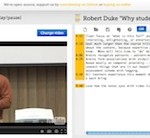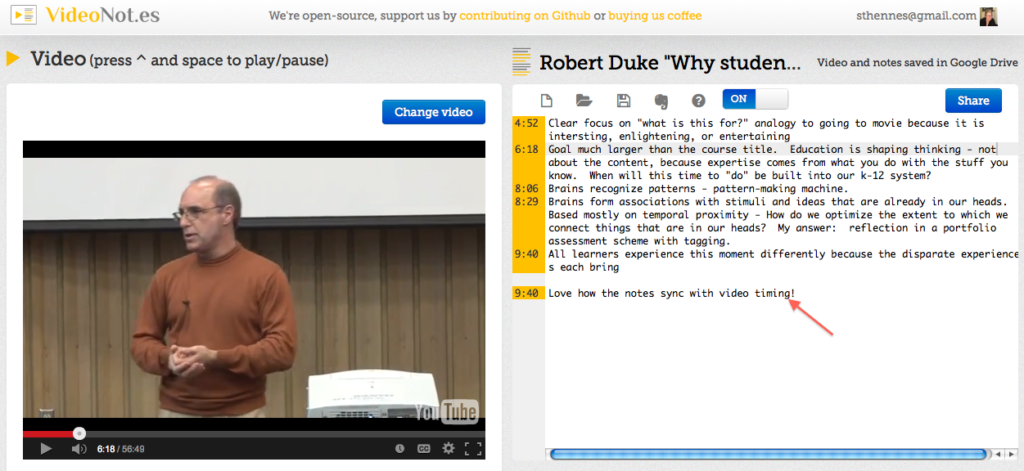Encourage critical thinking & discussion with note-taking
 I have been excited lately with the potential of using VideoNot.es in blended classrooms to support active participation in video viewing. VideoNot.es is a web-based tool that allows users to take notes while watching a video. Here is an example of some notes I took while watching Robert Duke’s video “Why Students Don’t Learn What We Think We Teach”
I have been excited lately with the potential of using VideoNot.es in blended classrooms to support active participation in video viewing. VideoNot.es is a web-based tool that allows users to take notes while watching a video. Here is an example of some notes I took while watching Robert Duke’s video “Why Students Don’t Learn What We Think We Teach”
The added value of Videonot.es is the tool syncs with the user’s Google Drive so the notes are automatically saved and can be shared. The best part though is each typed note is time-stamped so when viewing your notes (or mine if I share with you), you can click on the time-stamp and the video is cued up to that very spot. And, the person with whom you share can add to the notes (notice the arrow above pointing to a note added by one of my collaborators).
Using videos as instructional tools is common. Whole group viewing and discussions are certainly an important way to convey information and make meaning from what is viewed.
To that end, the MIT Blossoms program (Blended Learning Open Source Science or Math Studies) offers access to math and science videos in what they describe as “the lively video presence of a gifted guest teacher.” According to Putting Teachers at the Center of Education Technology the creators of Blossoms call their program’s “blend of computers and people a ‘teaching duet'” because in-class teachers facilitate active learning exercises interspersed through the viewing of math and science videos.
In addition to whole-group engaged viewing, teachers and students benefit from individual and small group second or third active viewing experiences using tools like VideoNot.es or Edpuzzle. Teachers can prompt students to think and engage with the content and open a window into the learning process when they embed questions in a video via EdPuzzle or assign note-taking with a specific focus through VideoNot.es.
For more ways to encourage active participation in viewing, take a look at the advice offered in this article by Emily A. Moore in Faculty Focus: From Passive Viewing to Active Learning: Simple Techniques for Applying Active Learning Strategies to Online Course Videos
And I particularly like these tips from the University of Arkansas to promote critical thinking and active learning through video viewing:
Predict, Observe, Evaluate (POE)
- Can be instructor produced, student produced, or existing (10-20 minutes)
- Student views first part of video setting up scenario
- Student predicts what should happen next
- Student observes the actual result
- Student evaluates the original prediction
Ten Frame Analysis
- Student produces from existing video
- Assign video to view.
- Students will, individually or in groups, take ten screen shots from the video that they feel describe the issue.
- Students will describe why they feel these screen shots effectively describe the issue, as they see it.
- Students will submit an assignment with the screen shots and documentation or present to the class (video presentation in discussion board or through web conferencing).
Empathy
- Appropriate for Affective Domain objectives
- Assign video to view.
- Students will complete a survey or have a discussion (in discussion board or web conferencing) to describe how they felt about the topic before and after viewing the video.
- If students’ views changed, ask them what changed their minds.



Active video viewing http://t.co/MdM2CDw8zV
Active video viewing http://t.co/fNJ3bkC54T via @innovativeEd
New goal: find a way to use this stuff with my classes. “@innovativeEd: Active video viewing http://t.co/M9wMn2wPgW”
Active video viewing http://t.co/PdDjYepzWX #edtech
Tarrant Institute for Innovative Education. Edtech news and how-to’s for the 21st century learning environment http://t.co/yS9QWyBOP5
Active video viewing – Innovation: Education http://t.co/68K5ObQrMY
Active video viewing http://t.co/ftBVfUFZun
Active video viewing – Innovation: Education http://t.co/sMZdXfNEVU
RT @lixre: Active video viewing http://t.co/ftBVfUFZun